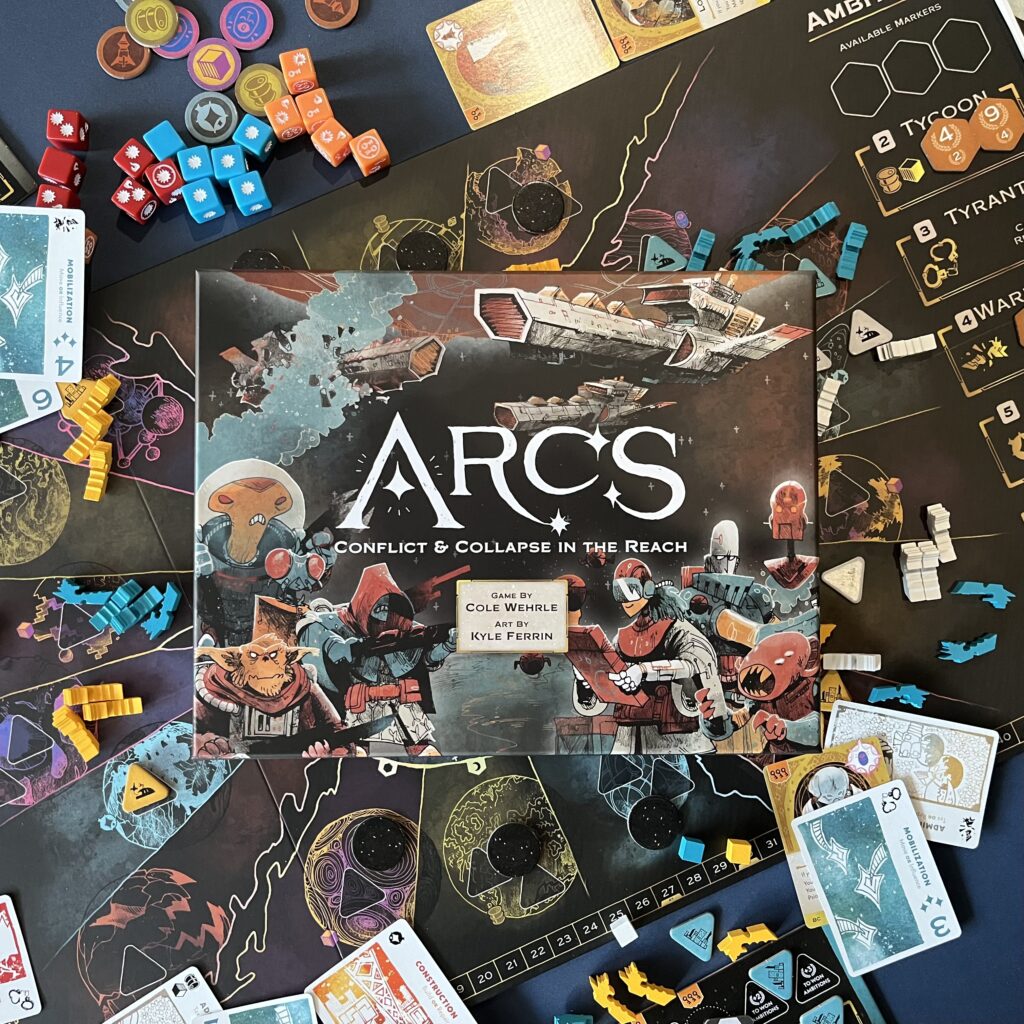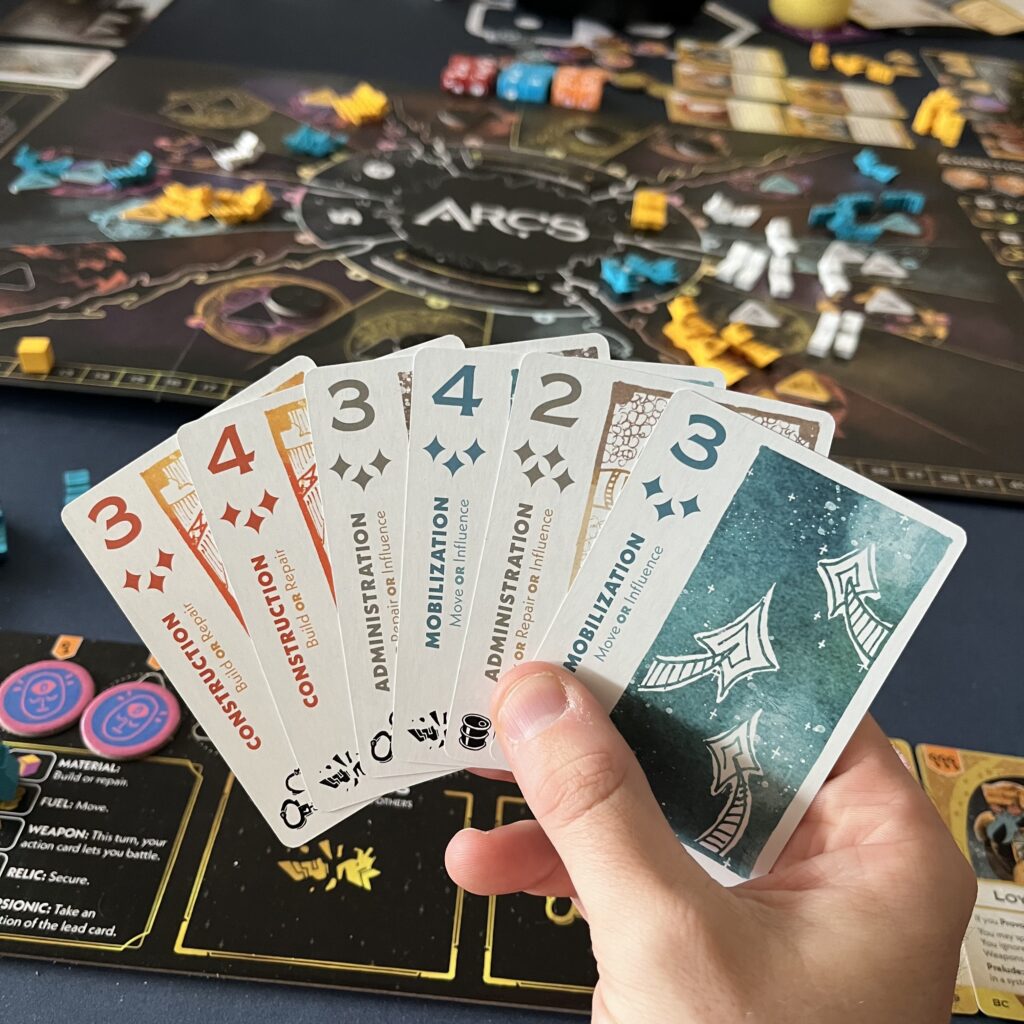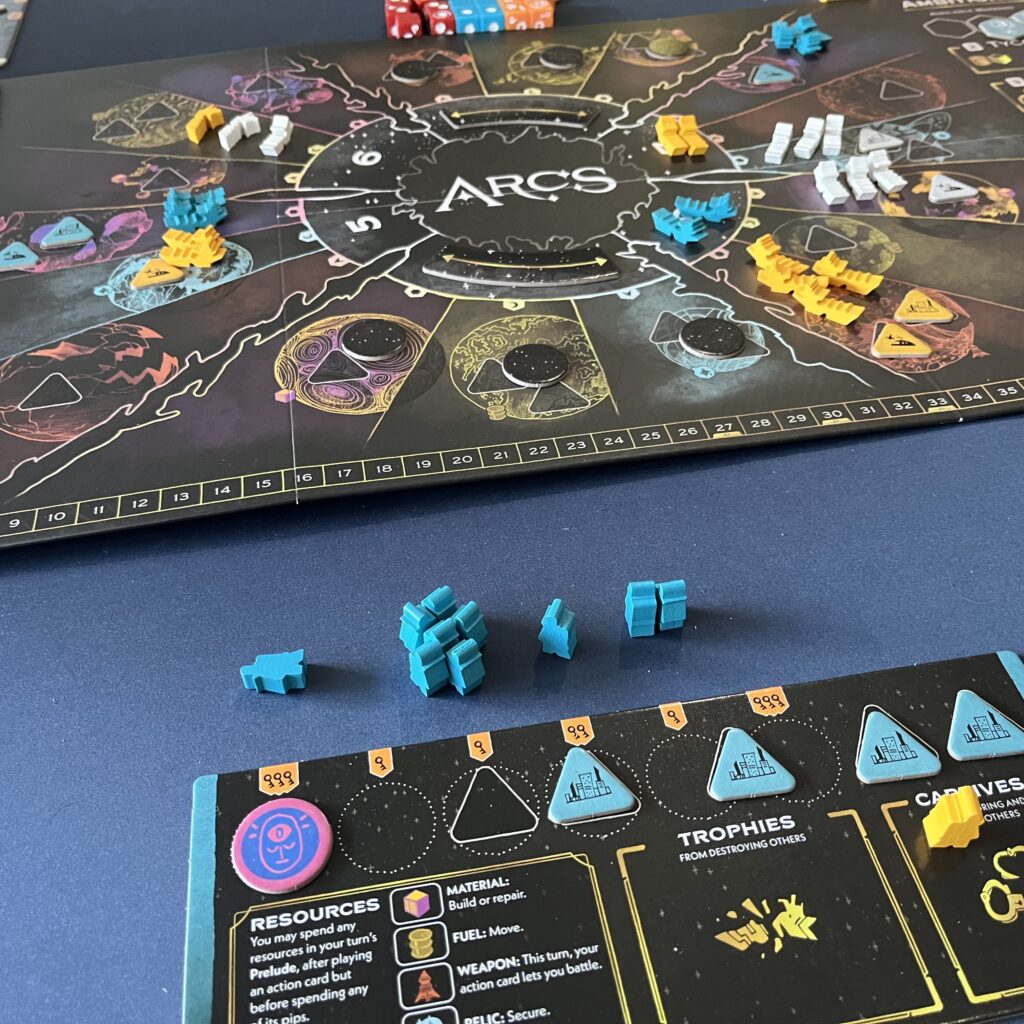At the edge of the vast, dark universe is the dangerous Reach. Players try to survive here, but it is not nearly as easy as you might think. In Reach, you have to be constantly on your guard for other players, because in Arcs everyone is ambitious, seeking power and conflict and misfortune are always present.
Background
Arcs is the new game from Leder Games, the publisher that always publishes unusual and often asymmetrical games with artwork by Kyle Ferrin and titles of just four words. Think of Ahoy, Fort, Vast, Root and Oath. The two latter games, by the way, were conceived by Cole Wehrle, who, besides Root, you might also know as the author of Pax Pamir. Wehrle is known for his intriguing and surprising game concepts. The same applies to Arcs.
Goal and setup
Arcs is once sci-fi strategy game in which players will compete with each other for initiative, ambitions and, of course, power. Power is the most important thing, as it allows you to claim victory. In this review, by the way, I will only discuss the base game in detail. There are already some expansions and modules available, but you may discover these for yourself once you are familiar with the base game.

A game of Arcs usually lasts from 3 to 5 chapters. After chapter 5, the game ends anyway. If a player has gained enough mach at the end of a chapter, the game ends and that player has won. If no player has enough mach at the end of a chapter, then a new chapter is played.
At the beginning of the game, players place the game board in the centre of the table. Based on the set-up card and depending on the number of players, some sectors on the game board are covered. The game board consists of 6 sectors, each consisting of 4 systems (3 planets and 1 gate). There is also space on the game board to place cards and keep track of the different ambitions. On the game board, the deck of cards is placed and also: the marker to keep track of power, the marker to keep track of chapters and the chits to declare ambition and to keep track of points for ambition. A row of cards forming the court is placed next to the game board.
Each player gets their own player board, wooden spaceships, wooden agents and building chits (with starports and cities). Each player places ships and buildings on the game board depending on the setup card and players are ready to play.
Gameplay
As described above, Arcs is played in so-called chapters. Each chapter consists of a varying number of rounds, depending on how many cards players have in hand and play.
Each round, a player comes out with a card starting with the player currently holding the initiative. Then the round is played clockwise. A player can only come out with one card if that player has another. If the player with the initiative has no more cards or does not want to come out, then initiative shifts clockwise.


The way players play their cards can be compared to a trick taking game, but don’t get too attached to that comparison. Each card has a value, a number of possible actions, a quantity of actions you can perform during your turn and an ambition symbol. The player with the initiative determines the leading colour. This player may then perform all possible actions and as many times as perform pips on the card. Each colour offers a fixed combination of different actions. The player may also choose to declare an ambition, the played card now has a value of 0, but the highest available ambition token may now be placed on the ambition corresponding to the card on the board. Ambitions are goals that players can fulfil during a chapter to accumulate power and therefore points.
Other players now have a number of options. If they follow the leading colour with a card in the same colour, but with a higher value, they can also perform the full amount of actions on their card. Players can ok choose to play a card closed to follow 1 action of the leading colour or open play a card in another colour and perform a single action of that.
The player who came out with the highest value in the leading colour gets the initiative and may come out first in the next round. There is also another possibility to steal the initiative and that is with a ‘seize’. By discarding an extra card, you get the initiative. During the round, other player cannot win that.
The cards show different action possibilities and the colours determine the combinations or possibilities:
- By levying taxes, players earn resources with their cities. They get the resource from a city in a planet they control or from a loyal city. So players can also tax in other players’ cities, as long as they control the planet. If you levy taxes in an opponent’s city, you may even remove an agent from the court and imprison him.
- Building allows players to build new cities, starports and ships. You can only build ships at a starport in your colour. Buildings can only be built on planets where you have ships. If you don’t control the system where you build, your ships or buildings will be damaged in the game.
- With move, you can manoeuvre your ships around the board.
- Repairing allows you to patch up buildings and/or ships.
- Players can influence and place agents on guild cards in the court.
- If you have the most influence on guild cards, you can secure them and place them in front of you to use their special effects.
- The last action is fighting. If you are present with ships in a system where another player’s pieces are also present, you can engage in combat, rolling as many dice as undamaged ships you have. There are three types of dice with a different distribution of symbols. For instance, with the red dice you can deal heavy blows, but there is a good chance that you yourself will also take damage. With battles, you can potentially destroy cities with negative and positive consequences. Fighting may also allow you to plunder and steal resources or guild cards from another player.
By discarding resources, before applying the action or actions of their played action card, players can perform the actions associated with the resources. These actions largely correspond to the actions on cards and thus offer players extra opportunities to make combinations of actions. With the guild cards, players can unlock even more possibilities.
So, simply put, a chapter ends when players’ action cards have been played. Some players may have played out earlier. At the end of the chapter, active ambitions are scored and player players continue until someone has enough points, or the end of the fifth chapter is reached.
Conclusions
Like Root and Oath, this new game from Cole Wehrle once again offers a huge amount of possibilities and new experiences. The game is immensely exciting until the end due to its balanced gameplay and streamlined and refined gameplay in which players have to play their cards smartly, taking into account the cards their opponents may still have.


As with trick taking games, good management of hand cards is absolutely key, as it determines which player has the initiative and thus gets to start a round and which ambitions may be declared. Those ambitions are an interesting way in which the score is awarded. Indeed, players decide which ambitions are active during a round, which makes for a tactical and dynamic gameplay that requires players to be constantly on guard and adapt quickly. With beautiful artwork by Kyle Ferrin and extraordinary gameplay by Cole Wehrle, Leather Games manages to put together another great game.



